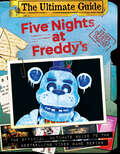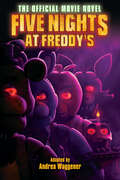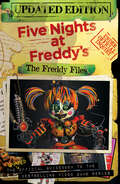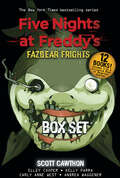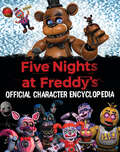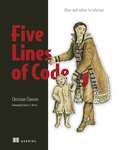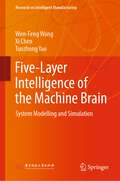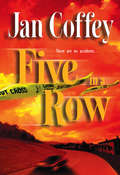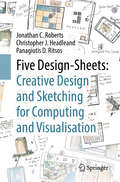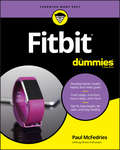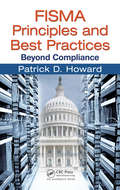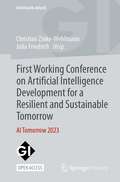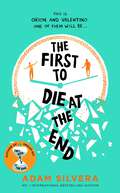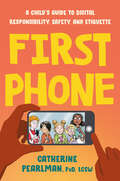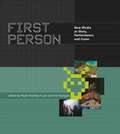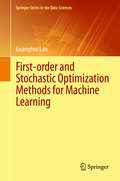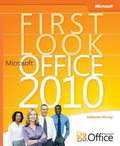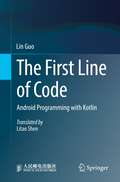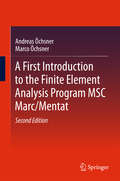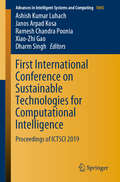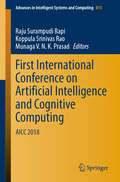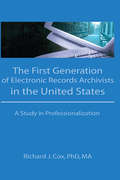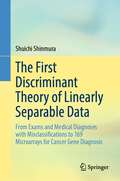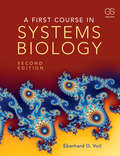- Table View
- List View
Five Nights at Freddy's Ultimate Guide: An AFK Book
by Scott CawthonFans won't want to miss this ultimate guide to Five Nights at Freddy’s -- bursting with theories, lore, and insights from the games, books, and more!This all-encompassing guidebook concentrates material from The Freddy Files (Updated Edition) and adds over 100 pages of new content exploring Help Wanted, Curse of Dreadbear, Fazbear Frights, the novel trilogy, and more!Fans hungry for fresh Five Nights at Freddy's lore can sink their teeth into this massive guidebook packed with mythology, gameplay, and secrets to help unwind the twisted mysteries lurking behind the smiling face of Fazbear Entertainment. Delving into each game, players can map the animatronics' paths, learn how timed elements of the games work, and discover how to trigger unique events. Special sections throughout highlight FNAF fans' most talked-about topics, from the alternate endings in Help Wanted and Curse of Dreadbear, to the new technology introduced in Fazbear Frights, to the ways that Easter eggs, rare screens, and hidden content can shed light on some of the more elusive questions in the FNAF universe. A comprehensive animatronics inventory and reproduced content from the Fazbear Entertainment Archives complete this compendium, helping fans bring their theories straight to the source. All the evidence, along with every detail of the games, books, and more, is laid out for fans to explore in this one-of-a-kind guide to the warped world of Five Nights at Freddy's.
Five Nights at Freddy's: The Official Movie Novel (Five Nights At Freddy's)
by Scott Cawthon Emma Tammi Seth CuddebackThe official movie novelization of the Five Nights at Freddy's movie!The hugely anticipated Five Nights at Freddy's movie from director Emma Tammi starring Matthew Lillard (Scream, Scooby-Doo) and Josh Hutcherson (The Hunger Games series, The Disaster Artist) hits theaters on October 27th, 2023, with a script from creator Scott Cawthon, Seth Cuddeback, and Emma Tammi. This movie novelization is a must-have for any Freddy fan!
Five Nights At Freddy's: The Freddy Files (Five Nights At Freddy's Ser.)
by Scott CawthonThe bestselling Freddy Files is back, now updated with 64 pages of new content!The bestselling, official guidebook to Five Nights at Freddy's is back, now updated and including 64 pages of new content exploring Freddy Fazbear's Pizzeria Simulator and Ultimate Custom Night!In this official guidebook to Five Night at Freddy's, fans and gamers alike can immerse themselves in the series' mythology, gameplay, and secrets as we unwind the twisted mysteries hidden at the heart of Freddy Fazbear's Pizza. Delving into each game, players can map the animatronics' paths, learn how timed elements of the games work, and discover how to trigger unique events. Special sections throughout highlight Freddy's fans' most talked-about theories, from the identities of the "Bite of '83 and '87" victims to the history of Henry and William Afton to the recurring hallucinations of "it's me." All the evidence, along with every detail of the games, books, and more, is laid out for fans to explore in this one-of-a-kind guide to the warped world of Five Nights at Freddy's.
Five Nights at Freddy's Fazbear Frights Collection - An AFK Book (Five Nights At Freddy's)
by Scott Cawthon Kira Breed-WrisleyFrom the #1 New York Times bestselling author and creator of Five Nights at Freddy's, don't miss this twelve-book boxed set, which includes stories that were left on the cutting room floor from books one through eleven!All eleven Fazbear Frights books in one amazing collection, plus a twelfth book of bonus stories – stories that didn't make the cut for the first eleven books! Five Nights at Freddy's creator Scott Cawthon spins three sinister novella-length in each book of this collection, with stories from different corners of his series' canon.
Five Nights at Freddy's Character Encyclopedia (Five Nights At Freddy's)
by Scott CawthonAn in-depth look at all the characters from Five Nights at Freddy's in a beautiful, deluxe hardcover format!The massive roster of characters from Five Nights at Freddy's is presented here in a giant hardcover that will make the perfect addition to any fan’s library. From the games to the novels and short stories, all the characters are here and laid out in awesome detail that will deepen the knowledge of even the most enthusiastic player. With over 200 pages of full-color art, this encyclopedia is not to be missed!
Five Lines of Code: How and when to refactor
by Christian ClausenFive Lines of Code teaches refactoring that's focused on concrete rules and getting any method down to five lines or less! There&’s no jargon or tricky automated-testing skills required, just easy guidelines and patterns illustrated by detailed code samples.In Five Lines of Code you will learn: The signs of bad code Improving code safely, even when you don&’t understand it Balancing optimization and code generality Proper compiler practices The Extract method, Introducing Strategy pattern, and many other refactoring patterns Writing stable code that enables change-by-addition Writing code that needs no comments Real-world practices for great refactoring Improving existing code—refactoring—is one of the most common tasks you&’ll face as a programmer. Five Lines of Code teaches you clear and actionable refactoring rules that you can apply without relying on intuitive judgements such as &“code smells.&” Following the author&’s expert perspective—that refactoring and code smells can be learned by following a concrete set of principles—you&’ll learn when to refactor your code, what patterns to apply to what problem, and the code characteristics that indicate it&’s time for a rework. Purchase of the print book includes a free eBook in PDF, Kindle, and ePub formats from Manning Publications. About the technology Every codebase includes mistakes and inefficiencies that you need to find and fix. Refactor the right way, and your code becomes elegant, easy to read, and easy to maintain. In this book, you&’ll learn a unique approach to refactoring that implements any method in five lines or fewer. You&’ll also discover a secret most senior devs know: sometimes it&’s quicker to hammer out code and fix it later! About the book Five Lines of Code is a fresh look at refactoring for developers of all skill levels. In it, you&’ll master author Christian Clausen&’s innovative approach, learning concrete rules to get any method down to five lines—or less! You&’ll learn when to refactor, specific refactoring patterns that apply to most common problems, and characteristics of code that should be deleted altogether. What's inside The signs of bad code Improving code safely, even when you don&’t understand it Balancing optimization and code generality Proper compiler practices About the reader For developers of all skill levels. Examples use easy-to-read Typescript, in the same style as Java and C#. About the author Christian Clausen works as a Technical Agile Coach, teaching teams how to refactor code. Table of Contents 1 Refactoring refactoring 2 Looking under the hood of refactoring PART 1 LEARN BY REFACTORING A COMPUTER GAME 3 Shatter long function 4 Make type codes work 5 Fuse similar code together 6 Defend the data PART 2 TAKING WHAT YOU HAVE LEARNED INTO THE REAL WORLD 7 Collaborate with the compiler 8 Stay away from comments 9 Love deleting code 10 Never be afraid to add code 11 Follow the structure in the code 12 Avoid optimizations and generality 13 Make bad code look bad 14 Wrapping up
Five-Layer Intelligence of the Machine Brain: System Modelling and Simulation (Research on Intelligent Manufacturing)
by Wen-Feng Wang Xi Chen Tuozhong YaoThis book intends to report the new results of the efforts on the study of Layered Intelligence of the Machine Brain (LIMB). The book collects novel research ideas in LIMB and summarizes the current machine intelligence level as “five layer intelligence”- environments sensing, active learning, cognitive computing, intelligent decision making and automatized execution. The book is likely to be of interest to university researchers, R&D engineers and graduate students in computer science and electronics who wish to learn the core principles, methods, algorithms, and applications of LIMB.
Five in a Row
by Jan CoffeyA Porsche careens out of control in a crowded parking lot. A brand-new SUV smashes through a dealership's plate-glass window. A Mercedes races wildly down a pier before diving off the end onto the deck of a yacht. Then two more wrecks. Witnesses report the vehicles had "a mind of their own" before each accident. Five in a row can't be a coincidence. Computer guru Emily Doyle has become the single-minded focus of a hacker determined to capture her attention. She recognizes the technology that is being used to gain control of the vehicles -- and in some way, she is connected to each of the victims. Ben Colter is the investigator called in by the automakers to find the link. As the casualties mount, Emily and Ben must unravel the puzzle of the seemingly random attacks, as a twisted mind moves from virtual reality to international terrorism.
Five Design-Sheets: Creative Design and Sketching for Computing and Visualisation
by Jonathan C. Roberts Christopher J. Headleand Panagiotis D. RitsosThis book describes a structured sketching methodology to help you create alternative design ideas and sketch them on paper. The Five Design-Sheet method acts as a check-list of tasks, to help you think through the problem, create new ideas and to reflect upon the suitability of each idea. To complement the FdS method, we present practical sketching techniques, discuss problem solving, consider professional and ethical issues of designing interfaces, and work through many examples.Five Design-Sheets: Creative Design and Sketching for Computing and Visualization is useful for designers of computer interfaces, or researchers needing to explore alternative solutions in any field. It is written for anyone who is studying on a computing course and needs to design a computing-interface or create a well-structured design chapter for their dissertation, for example. We do acknowledge that throughout this book we focus on the creation of interactive software tools, and use the case study of building data-visualization tools. We have however, tried to keep the techniques general enough such that it is beneficial for a wide range of people, with different challenges and different situations, and for different applications.
Fitbit For Dummies
by Paul McFedriesTake a complete tour of the Fitbit ecosystem From Fitbit features to the Fitbit app to the social features of Fitbit.com, this approachable book covers everything you need to know to get the most out of your Fitbit wristband or watch. Whether you’re a fitness newcomer, a regular walker, or a long-time exerciser, your Fitbit is a powerful device that can tell you much more than how many steps you take each day. This book offers easy-to-follow, step-by-step instructions for tracking all that data and getting the most out of your Fitbit investment. Go beyond steps to track sleep, heart rate, weight, and more Set up your health and fitness goals — then go for them! Connect to third-party apps such as Strava and Weight Watchers Stay motivated by sharing your activities with friends It’s one thing to simply wear your Fitbit, but it’s quite another to use your Fitbit to reach your personal health goals. Whether that goal is to get fit, lose weight, eat better, or reduce stress, your Fitbit has settings and features that can help you get there. And this book shows you how!
FISMA Principles and Best Practices: Beyond Compliance
by Patrick D. HowardWhile many agencies struggle to comply with Federal Information Security Management Act (FISMA) regulations, those that have embraced its requirements have found that their comprehensive and flexible nature provides a sound security risk management framework for the implementation of essential system security controls. Detailing a proven appro
First Working Conference on Artificial Intelligence Development for a Resilient and Sustainable Tomorrow: AI Tomorrow 2023 (Informatik aktuell)
by Christian Zinke-Wehlmann Julia FriedrichKünstliche Intelligenz ist ein Treiber der digitalen Transformation von Unternehmen, welche die gesamte Organisation, einschließlich ihrer Strukturen, Prozesse und Mitarbeitender berührt.Die AI Tomorrow Konferenz möchte die menschzentrierte Perspektive auf KI und ihren nachhaltigen Einsatz, im ökologischen wie auch ökonomischen und sozialen Sinne, stärker ins Zentrum des wissenschaftlichen Diskurses rücken.Dies ist ein Open-Access-Buch.Der Inhalt: Die Autor:innen beleuchten Aspekte der KI-Entwicklung und des Einsatzes. Nach einer Einführung zu Resilienz und Nachhaltigkeit von KI erscheinen die Beiträge entsprechend ihrer Zuordnung zu den Konferenzsessions:(I) Digital transformation of organizations or processes through AI(II) Opportunities of AI for society(III) AI supported knowledge management and learning(IV) Manufacturing and factories of the futureDie Zielgruppe: Wissenschaftler:innen und Interessierte aus dem Bereich der Angewandten Informatik
The First to Die at the End: The prequel to the international No. 1 bestseller THEY BOTH DIE AT THE END!
by Adam SilveraIn this prequel to the NO. 1 INTERNATIONAL BESTSELLING phenomenon of TIKTOK fame, They Both Die at the End, two new strangers spend a life-changing day together after Death-Cast make their first fateful calls. '[A] heart-pounding story [full] of emotion and suspense.' Kirkus 'An extraordinary book with a riveting plot.' BooklistMeet Orion and Valentino. It&’s the night before Death-Cast goes live, and there&’s one question on everyone&’s mind: Can Death-Cast actually predict death, or is it an elaborate hoax? Orion Pagan has waited years for someone to tell him that he&’s going to die, given his serious heart condition. Valentino Prince has a long and promising future ahead of him and only registered for Death-Cast after his twin sister nearly died in a car accident. Orion and Valentino cross paths in Times Square and immediately feel a deep connection. But when the first End Day calls go out, their lives are changed for ever – one of them receives a call . . . the other doesn&’t. Told with acclaimed author Adam Silvera&’s signature bittersweet touch, this story celebrates the lasting impact that people have on each other and proves that life is always worth living to the fullest. PRAISE FOR ADAM SILVERA: 'There isn't a teenager alive who won't find their heart described perfectly on these pages.' Patrick Ness, author of The Knife of Never Letting Go 'Adam Silvera is a master at capturing the infinite small heartbreaks of love and loss and grief.' Nicola Yoon, author of Everything, Everything 'A phenomenal talent.' Juno Dawson, author of Clean and Wonderland 'Bold and haunting.' Lauren Oliver, author of Delirium
First Phone: A Child's Guide to Digital Responsibility, Safety, and Etiquette
by Catherine PearlmanA fun and informative illustrated kids&’ guide to safely and productively navigating the digital landscape.Cellphones have become a fact of life, with children as young as eight (yes, eight!) getting their very own &“devices.&” Such boundless access means our kids are in nearly constant contact with technology that was designed specifically for adults. And they&’re doing so without any type of road map. Enter First Phone: the essential book that apprehensive parents can confidently hand to their kids to read as they begin their journey into the digital world. In First Phone, Catherine Pearlman—licensed clinical social worker and parenting expert—speaks directly to eight- to twelve-year-old children about digital safety in a manner that is playful, engaging, and age-appropriate. With insights and strategies supported by the latest research, First Phone offers: • guidance on privacy, boundaries, social media, and even sexting (yes, young children need to learn about sexting before it happens!) • best digital hygiene and self-care practices, including when to put the darn phone down, when to turn off notifications, and where to charge • how to be a kind and compassionate upstander in a digital world An essential companion when your child receives their first phone, this book provides kids the tools and information they need while giving their parents peace of mind.
First Person: New Media as Story, Performance, and Game
by Noah Wardrip-Fruin Pat HarriganYet it is widely believed that the market for electronic literature- predicted by some to be the future of the written word- languishes. Even bestselling author Stephen King achieved disappointing results with his online publication of "Riding the Bullet" and "The Plant." Isn't it possible, though, that many hugely successful computer games- those that depend on or at least utilize storytelling conventions of narrative, character, and theme- can be seen as examples of electronic literature? And isn't it likely that the truly significant new forms of electronic literature will prove to be (like games) so deeply interactive and procedural that it would be impossible to present them as paper-like "e-books"? The editors of First Person have gathered a remarkably diverse group of new media theorists and practitioners to consider the relationship between "story" and "game," as well as the new kinds of artistic creation (literary, performative, playful) that have become possible in the digital environment. This landmark collection is organized as a series of discussions among creators and theorists; each section includes three presentations, with each presentation followed by two responses. Topics considered range from "Cyberdrama" to "Ludology" (the study of games), to "The Pixel/The Line" to "Beyond Chat." The conversational structure inspired contributors to revise, update, and expand their presentations as they prepared them for the book, and the panel discussions have overflowed into a First Person website (created in conjunction with the online journal Electronic Book Review).
First-order and Stochastic Optimization Methods for Machine Learning (Springer Series in the Data Sciences)
by Guanghui LanThis book covers not only foundational materials but also the most recent progresses made during the past few years on the area of machine learning algorithms. In spite of the intensive research and development in this area, there does not exist a systematic treatment to introduce the fundamental concepts and recent progresses on machine learning algorithms, especially on those based on stochastic optimization methods, randomized algorithms, nonconvex optimization, distributed and online learning, and projection free methods. This book will benefit the broad audience in the area of machine learning, artificial intelligence and mathematical programming community by presenting these recent developments in a tutorial style, starting from the basic building blocks to the most carefully designed and complicated algorithms for machine learning.
First Look: Microsoft® Office 2010
by Katherine MurrayWelcome to Office 2010. Whether you work primarily in the office or on the go, you'll find smart tools in this release that enable you to get your work done easier, faster, and more professionally than ever. This book will inspire you and give you a good sense of the exciting features in Office 2010. This book was written while the software was in development, so you may find some variance in screen illustrations and procedures. Part I, "Envision the Possibilities," introduces you to the changes in Office 2010 and shows you how you can make the most of the new features to fit the way you work today. Chapter 1, "Welcome to Office 2010," gives you a play-by-play introduction to new features; Chapter 2, "Express Yourself Effectively and Efficiently," details the great feature enhancements and visual effects throughout the applications; and Chapter 3, "Work Anywhere with Office 2010," explores the flexibility factor by presenting a set of scenarios that enable users to complete their work no matter where their path takes them. Part II, "Hit the Ground Running," focuses on each of the Office 2010 applications in turn, spotlighting the key new features and showing how they relate to the whole. These chapters provide a how-to guide for many of the top features you're likely to use right off the bat, and they offer inspiring ideas on how to get the most from your favorite applications. Part III, "Next Steps with Office 2010," zooms up to the big picture and provides examples to help you think through interoperability. How often do you use the various Office applications together? Customer research shows that people often don't realize how well the applications work together as a complete system--which means they might be laboring over items they could easily incorporate from somewhere else. This part of the book provides examples for integrating the applications and explores Office 2010 security and training opportunities, as well.
The First Line of Code: Android Programming with Kotlin
by Lin GuoThe First Line of Code is a must-have for developers who want to learn Android and Kotlin, and the best-seller in China. Knowledge between Android and Kotlin is interspersed in a way that readers are easy to understand and get start:· Android part covers all the important aspects of the Android platform, such as activity, service, content provider, broadcast receiver, fragment, basic UI, data storage, network, Jetpack and other application-level knowledge. · Kotlin part covers various aspects of Kotlin, such as standard grammar, common skills, higher-order functions, generics, coroutines, DSL and other language-level knowledge. In addition, The First Line of Code is a very practicing book, illustrating concepts with a complete weather forecast program. You can use and practice all the knowledge comprehensively after learning and see the actual result for what you have learned through the book. All contents of the book are quite easy to understand. It might be a good choice for both beginners and experienced developers. Also suitable for college students, college teachers, etc.
A First Introduction to the Finite Element Analysis Program MSC Marc/Mentat
by Andreas Öchsner Marco ÖchsnerThis book offers a brief introduction to the general-purpose finite element program MSC Marc, focusing on providing simple examples, often single-element problems, which can easily be related to the theory that is discussed in finite element lectures. As such, it is an ideal companion book to classical introductory courses on the finite element method. MSC Marc is a specialized program for non-linear problems (implicit solver), which is distributed by the MSC Software Corporation and commonly used in academia and industry. The documentation of all finite element programs now includes a variety of step-by-step examples of differing complexity, and all software companies offer professional workshops on different topics. Since the first edition of the book, there have been several new releases of Marc/Mentat and numerous changes. This new edition incorporates the latest Marc/Mentat software developments and new examples.
First International Conference on Sustainable Technologies for Computational Intelligence: Proceedings of ICTSCI 2019 (Advances in Intelligent Systems and Computing #1045)
by Xiao-Zhi Gao Dharm Singh Ashish Kumar Luhach Janos Arpad Kosa Ramesh Chandra PooniaThis book gathers high-quality papers presented at the First International Conference on Sustainable Technologies for Computational Intelligence (ICTSCI 2019), which was organized by Sri Balaji College of Engineering and Technology, Jaipur, Rajasthan, India, on March 29–30, 2019. It covers emerging topics in computational intelligence and effective strategies for its implementation in engineering applications.
First International Conference on Artificial Intelligence and Cognitive Computing: Aicc 2018 (Advances In Intelligent Systems and Computing #815)
by Raju Surampudi Bapi Koppula Srinivas Rao Munaga V. PrasadThis book presents original research works by researchers, engineers and practitioners in the field of artificial intelligence and cognitive computing. The book is divided into two parts, the first of which focuses on artificial intelligence (AI), knowledge representation, planning, learning, scheduling, perception-reactive AI systems, evolutionary computing and other topics related to intelligent systems and computational intelligence. In turn, the second part focuses on cognitive computing, cognitive science and cognitive informatics. It also discusses applications of cognitive computing in medical informatics, structural health monitoring, computational intelligence, intelligent control systems, bio-informatics, smart manufacturing, smart grids, image/video processing, video analytics, medical image and signal processing, and knowledge engineering, as well as related applications.
The First Generation of Electronic Records Archivists in the United States: A Study in Professionalization
by Richard CoxThis book helps readers understand the current status of archivists in the United States. It addresses issues of professionalization by re-examining two major aspects of the archival community: institutional forms and structures, and the basic educational foundations that are important to any profession. While United States archivists now seem poised to develop new approaches to the management of electronic records, including research and education venues, this profession?s long journey to reach this point is an interesting step on the continuing road to professionalization. The First Generation of Electronic Records Archivists in the United States represents the first major study of how and why American archivists have struggled to contend with the management of electronic records. The book provides a framework for studying this issue, includes suggestions for additional research, and serves as a basis for discussion about the continued strengthening of the archival profession. Despite more than thirty years of striving to manage electronic records, American archivists have not developed an effective infrastructure for this purpose. The First Generation of Electronic Records Archivists in the United States considers the evidence for this failure by evaluating archival literature on the topic of electronic records management. It examines how position descriptions in state government archives and job advertisements across the discipline have reflected a bias toward paper-based formats, and the failure of graduate and continuing archival education programs to deal effectively with electronic records. The book details:state government archives and position descriptionstrends and practices in the Information Age, 1976--1990graduate archival education and electronic records: an analysis of current approaches and their strengths and weaknessesthe effectiveness of the NAGARA Institute as a form of advanced archival educationproblems, challenges, opportunities, and needs for additional researchThe First Generation of Electronic Records Archivists in the United States is an enlightening study for library and information science educators, archival graduate students, and archivists themselves as they work toward the professionalization of their field.
The First Discriminant Theory of Linearly Separable Data: From Exams and Medical Diagnoses with Misclassifications to 169 Microarrays for Cancer Gene Diagnosis
by Shuichi ShinmuraThis book deals with the first discriminant theory of linearly separable data (LSD), Theory3, based on the four ordinary LSD of Theory1 and 169 microarrays (LSD) of Theory2. Furthermore, you can quickly analyze the medical data with the misclassified patients which is the true purpose of diagnoses. Author developed RIP (Optimal-linear discriminant function finding the combinatorial optimal solution) as Theory1 in decades ago, that found the minimum misclassifications. RIP discriminated 63 (=26−1) models of Swiss banknote (200*6) and found the minimum LSD: basic gene set (BGS). In Theory2, RIP discriminated Shipp microarray (77*7129) which was LSD and had only 32 nonzero coefficients (first Small Matryoshka; SM1). Because RIP discriminated another 7,097 genes and found SM2, the author developed the Matryoshka feature selection Method 2 (Program 3), that splits microarray into many SMs. Program4 can split microarray into many BGSs. Then, the wide columnLSD (Revolution-0), such as microarray (n Theory3 shows the surprising results of six ordinary data re-analyzed by Theory1 and Theory2 knowledge. Essence of Theory3 is described by using cephalopelvic disproportion (CPD) data. RIP discriminates CPD data (240*19) and finds two misclassifications unique for cesarean and natural-born groups. CPD238 omitting two patients becomes LSD, which is the first case selection method. Program4 finds BGS (14 vars.) the only variable selection method for Theory3. 32 (=25) models, including BGS, become LSD among (219−1) models. Because Program2 confirms BGS has the minimum average error rate, BGS is the most compact and best model satisfying Occam’s Razor. With this book, physicians obtain complete diagnostic results for disease, and engineers can become a true data scientist, by obtaining integral knowledge ofstatistics and mathematical programming with simple programs.
A First Course in Systems Biology
by Eberhard VoitA First Course in Systems Biology is an introduction for advanced undergraduate and graduate students to the growing field of systems biology. Its main focus is the development of computational models and their applications to diverse biological systems. The book begins with the fundamentals of modeling, then reviews features of the molecular inventories that bring biological systems to life and discusses case studies that represent some of the frontiers in systems biology and synthetic biology. In this way, it provides the reader with a comprehensive background and access to methods for executing standard systems biology tasks, understanding the modern literature, and launching into specialized courses or projects that address biological questions using theoretical and computational means. New topics in this edition include: default modules for model design, limit cycles and chaos, parameter estimation in Excel, model representations of gene regulation through transcription factors, derivation of the Michaelis-Menten rate law from the original conceptual model, different types of inhibition, hysteresis, a model of differentiation, system adaptation to persistent signals, nonlinear nullclines, PBPK models, and elementary modes. The format is a combination of instructional text and references to primary literature, complemented by sets of small-scale exercises that enable hands-on experience, and large-scale, often open-ended questions for further reflection.
A First Course in Statistical Programming with R
by W. John Braun Duncan J. MurdochThis is the only introduction you'll need to start programming in R, the open-source language that is free to download, and lets you adapt the source code for your own requirements. Co-written by one of the R Core Development Team, and by an established R author, this book comes with real R code that complies with the standards of the language. Unlike other introductory books on the ground-breaking R system, this book emphasizes programming, including the principles that apply to most computing languages, and techniques used to develop more complex projects. Learning the language is made easier by the frequent exercises and end-of-chapter reviews that help you progress confidently through the book. Solutions, datasets and any errata will be available from the book's web site. The many examples, all from real applications, make it particularly useful for anyone working in practical data analysis.
